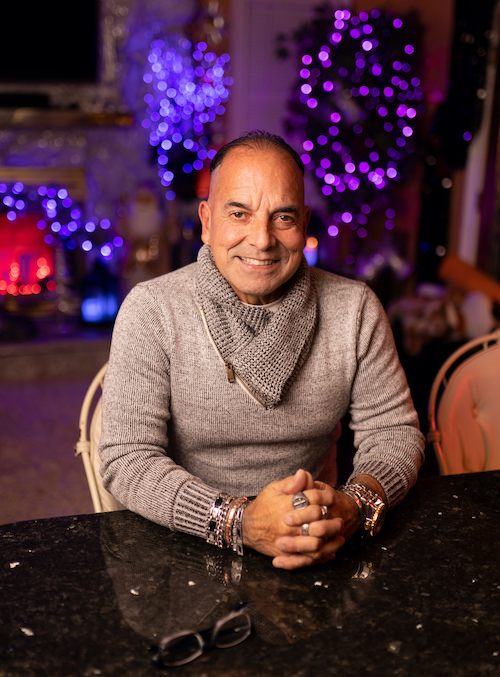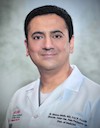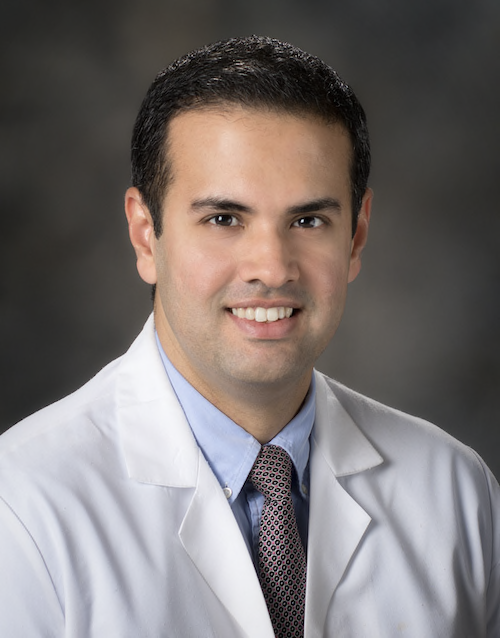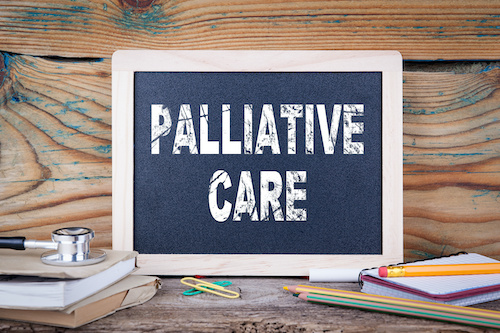Story by Mary Ann Littell • Portraits by John O'Boyle View the complete magazine | Subscribe to Cancer Connection
See the full video component of Diego's story
View more patient stories at cinj.org/patientstories
Meeting Diego Castiblanco, you would never guess he’s been battling late-stage liver cancer. At 61, he’s got vitality and energy to spare. A master carpenter with his own business, he and a small crew, including his brother Juan Manuel, make custom crown moldings, coffered ceilings, mantels, wainscoting, and more. “I’ve been doing this for 43 years,” he says. “It’s my hobby, it’s my job, and I love it.” Tooling around his hometown of Howell, New Jersey, in a big yellow Hummer, he goes to church, to his job sites, and to the gym for strength training and kung fu. In short, he lives his life.
He has much to be thankful for. At 175 pounds, he looks fit and sturdy. “I have the strength of a buffalo!” he exclaims. Yet only a year ago he was slumped in a wheelchair, praying for his own survival. He had just been diagnosed with stage 4 hepatocellular cancer (HCC), the most common type of primary liver cancer. It is among the leading causes of cancer deaths in the U.S. and worldwide. And when it is advanced, as it was in Castiblanco’s case, the five-year survival rate is only three percent.
Castiblanco’s health crisis began in January 2021, when he had a serious motorcycle accident. “The accident was bad. I broke two ribs and was in a lot of pain,” he says. “The emergency room doctors took X-rays and sent me home with pain medication, but it didn’t help.”
Castiblanco is no stranger to pain and adversity. He speaks openly about personal crises that eventually led him to alcoholism. Sixteen years ago he stopped drinking and turned his life around, helped by his longtime partner, Jana. “At that point, I felt God saved me, and I made a decision to devote myself to God,” he says somberly.
Unfortunately, the heavy drinking had taken its toll, damaging his liver. He has cirrhosis, a serious condition that causes scarring of the liver and increases an individual’s chances of developing HCC. Some 70 to 90 percent of all cases of liver cancer in the U.S. occur in livers that are cirrhotic. His cirrhosis had been treated at Robert Wood Johnson University Hospital (RWJUH) in New Brunswick.

When the results of Diego Castiblanco’s imaging studies and bloodwork indicated that he had liver cancer, he went straight to New Brunswick – to RWJUH and Rutgers Cancer Institute of New Jersey. “I’d heard about Rutgers Cancer Institute and knew they have the best specialists. It’s the smartest decision I ever made. It saved my life,” says Castiblanco (above).
Through the years of building his business, he felt strong and healthy. “Before the motorcycle accident, I had pain in my legs, but no symptoms that would indicate liver cancer,” he says. “Doctors said the pain was from a pinched nerve, from all the physical work I did. Unfortunately, my cancer was there for a long time, and many doctors missed it.”
In the days following his accident, the pain grew worse. On top of that, he began having symptoms of COVID-19. “I was miserable. I just couldn’t take it anymore,” he says. He called his daughter Alma, who lives ten minutes away, and asked her to drive him to a local hospital, where he had more imaging studies and tests, including one for COVID. “That’s when I found out I had COVID,” he says. “But there was worse news. The results of my imaging studies and bloodwork indicated I had liver cancer. They wanted to admit me, but I said no. I went straight to New Brunswick – to RWJUH and Rutgers Cancer Institute of New Jersey. I’d heard about Rutgers Cancer Institute and knew they have the best specialists. It’s the smartest decision I ever made. It saved my life.”
He was seen in the RWJUH emergency department, then admitted to a COVID unit, where he remained for almost two weeks. Doctors confirmed the diagnosis of stage 4 liver cancer and started him on a course of radiation to alleviate his pain.
Upon his discharge, Castiblanco was referred to Prateek Gulhati, MD, PhD, medical oncologist in the Gastrointestinal Oncology Program at Rutgers Cancer Institute, and assistant professor of medicine at Rutgers Robert Wood Johnson Medical School (RWJMS). He specializes in treating patients with pre-cancerous and cancerous conditions involving the esophagus, stomach, small intestine, liver, colon, rectum, pancreas, and other organs.
“I met Dr. Gulhati in early February 2021,” says Castiblanco. “I’d lost so much weight; I was down to 135 pounds. I was so weak I could barely walk.” “He had a large tumor and poor performance status, meaning that he was not able to perform many activities of daily living,” says Gulhati. There are a limited number of treatment options for disease that has spread beyond the liver and into other organs and/or lymph nodes. In Castiblanco’s case, the cancer had spread to his bones.
Gulhati put together a treatment plan for Castiblanco. “Before we could treat him, we had to get his pain under control, using a combination of medication and radiation treatment. Once the pain was controlled and his performance status improved, we would go after the cancer with a combination of immunotherapy (atezolizumab) with targeted therapy (bevacizumab),” notes the oncologist. This therapy, recently approved, is for people with advanced liver cancer that cannot be treated with surgery.
Atezolizumab is an immune checkpoint inhibitor, a type of treatment that helps the immune system seek out and destroy cancer. Bevacizumab, a targeted therapy, starves tumors by blocking the growth of new blood vessels. In clinical studies, this combination treatment resulted in improved rates of survival over other treatments. “Dr. Gulhati couldn’t promise me anything, but said the immunotherapy might help me live longer,” Castiblanco says. “What did I have to lose? I said yes, let’s go forward.”


Prateek Gulhati, MD, PhD (above, right), medical oncologist in the Gastrointestinal Oncology Program at Rutgers Cancer Institute, and assistant professor of medicine at Rutgers Robert Wood Johnson Medical School, and M. Hamza Habib, MD (above, left), director of outpatient palliative medicine and cancer pain service at Rutgers Cancer Institute and RWJUH were key members of Castiblanco’s healthcare team.
Gulhati arranged a consultation with M. Hamza Habib, MD, director of outpatient palliative medicine and cancer pain service at Rutgers Cancer Institute and RWJUH and assistant professor of medicine at RWJMS. The palliative care team at RWJUH includes board-certified physicians, nurse practitioners, a social worker, and a chaplain. While the team treats patients with many disorders, not just cancer, some 90 percent of their outpatient practice is cancer patients.
“Cancer pain is a serious and debilitating issue in itself, and can lead to great impairment of quality of life,” Dr. Habib explains. “Early palliative care provides cancer patients with effective pain and symptom management, allowing them to stay physically and mentally functional while getting cancer treatments.”
“Palliative care in oncology settings is often referred to as supportive oncology, due to the added support it provides to the ongoing cancer treatments,” he continues. “Our service is very collegial. We often see patients on the same day as the oncologist, sometimes in the same room, managing the patient together, which is very collaborative, and provides for effective real-time communication. That’s what we did for this patient.”
Castiblanco’s cancer-related pain was treated with multimodal analgesia, a method of pain management that combines various groups of medications for pain relief. His medication regimen included anti-inflammatories, muscle relaxants, opioids, and medications for nerve pain. These medications were gradually added in various stages for outpatient cancer pain management. He was also given prescription cannabinoid-analogue medication to improve his appetite.
Using medications from different drug classes decreases reliance on opioids, a real advantage, given the opioid abuse crisis. “Because this patient had a history of excessive alcohol use in the past, we gave him medicines that have less potential to be overused,” notes Habib. “We prescribed the minimal amount possible and followed him closely, both in the clinic and through telemedicine calls during the COVID spikes.”
A self-described ‘prayer warrior,’ Diego Castiblanco credits his faith, his physicians, and a wonderful team of nurses at Rutgers Cancer Institute for saving his life.
This treatment was just what Castiblanco needed. His weight and performance status improved with effective pain and symptom management, and he felt better. Before too long he was ready to begin the combination therapy regimen. He admits the treatments were rough: “In the beginning, I felt weak and tired. But before too long I didn’t have any side effects. I’m feeling great now. My weight is back to normal. I’m walking, driving, going to church, to job sites. Getting back to my regular life, a little more each day.”
Gulhati is cautiously optimistic about his patient’s overall improvement. “I’ve used this regimen on a few patients with variable results,” he notes. “Mr. Castiblanco has had an excellent response to it, in fact, the best I’ve seen. His tumors are shrinking, the pain is well controlled, and energy levels have improved significantly. We will keep him on this regimen as long as it continues to control the underlying disease and he is able to tolerate it.”
This self-described ‘prayer warrior,’ credits his faith, his physicians, and a wonderful team of nurses for saving his life. “The doctors and nurses are my angels,” he says. “They have so much compassion. They care for me and give me courage. They tell me, ‘Diego, you’re looking so good!’” He still receives pain therapy, but only at one-fifth of the original dosage, with plans to further taper down the doses, according to Habib.
Castiblanco adds: “I’m grateful that I have the opportunity to see my five grandchildren grow up, to see my customers enjoy our beautiful carpentry. I could not have gotten through this without the support of Jana and Alma and my youngest daughter, Briahna. They have done so much for me.” He is also grateful for prayers that have come in from members of his church.
For someone like Castiblanco, the benefits of seeking care at New Jersey’s only NCI-designated Comprehensive Cancer Center are incalculable. Says Gulhati: “We were able to offer him a multidisciplinary treatment approach involving medical oncology and radiation oncology, as well as pain management with palliative care. While we cannot predict what the future holds, as of now he is doing very well and living a full life.”

Did you know?
As you read in Diego Castiblanco’s story, palliative care is a subspecialty of medicine that focuses on the comprehensive treatment of pain and symptoms accompanying many serious illnesses, including cancer. Hospice focuses on end of life care when patients decide to no longer receive cancer treatment. The goal of palliative care, on the other hand, is to make sure patients do their best from a pain and symptoms standpoint while they continue to get their cancer treatments. In cancer settings, the oncologist manages the cancer, while the palliative care team manages the symptoms of cancer and side effects of related treatments.
It is a combined team effort to help patients live longer with a better quality of life. Unfortunately, there are times when the cancer is not curable. In this scenario, the palliative care team works with patients and their families to aid with difficult decision making that preserves dignity and quality at the end of life. Most palliative care teams offer a holistic approach to patient care, and work closely with other services like nutrition and physical therapy. They also work closely with social workers and therapists to help provide an extra layer of spiritual and emotional support through cancer and its treatments.
Dr. Habib, along with Samantha Nagengast, MD, director of the Palliative Medicine and Supportive Care Program at Rutgers Cancer Institute of New Jersey and Robert Wood Johnson University Hospital, and oncologist and palliative medicine physician Elizabeth Poplin MD, collaborate on the management of palliative care for patients with cancer.


